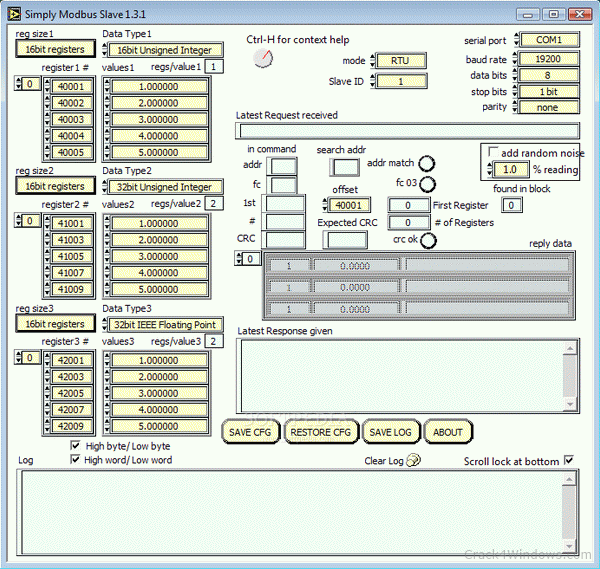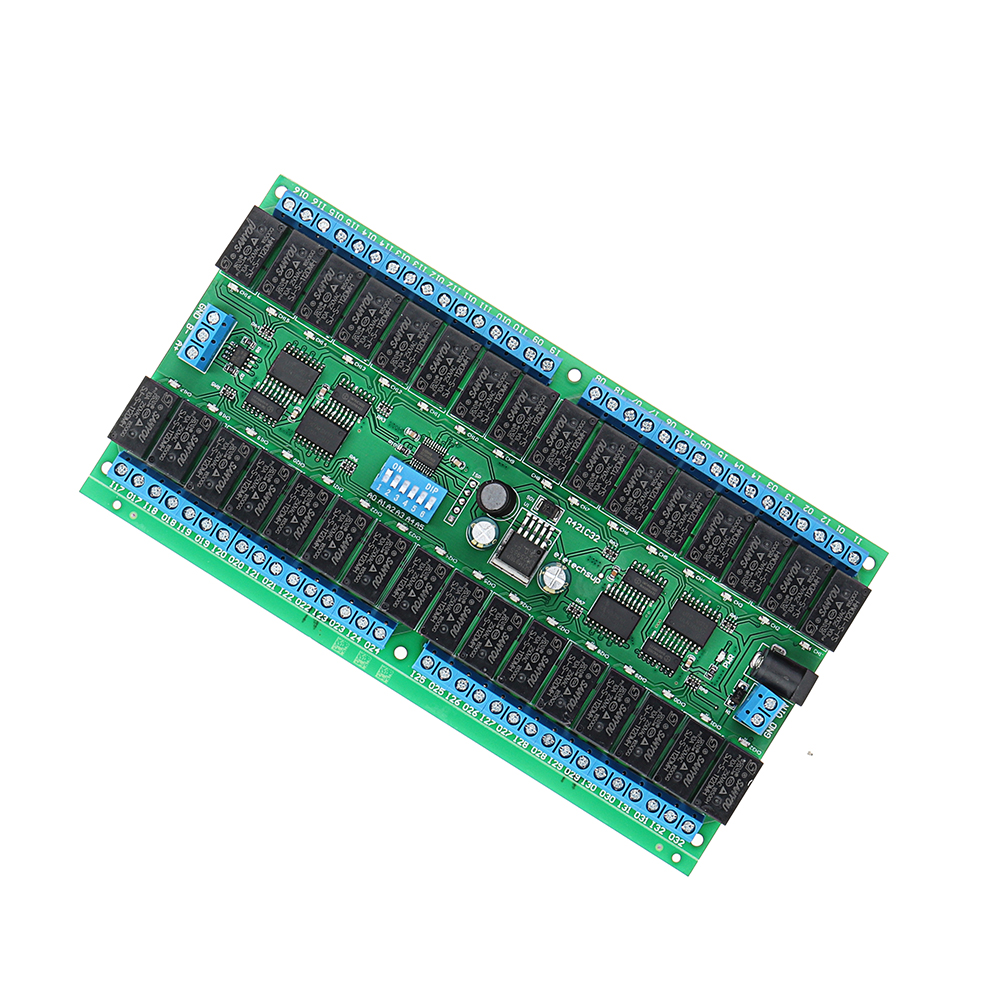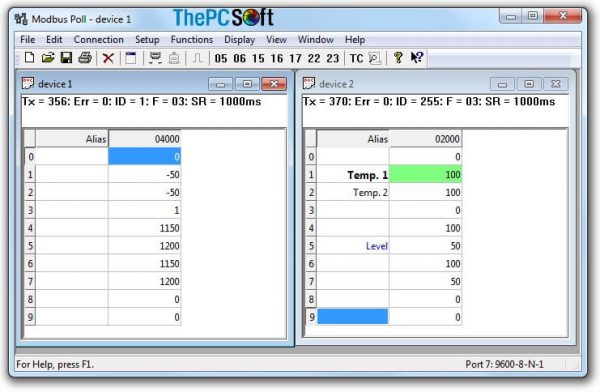Modbus remains the most widely available protocol for connecting industrial devices. The Modbus protocol specification is openly published and use of the protocol is royalty-free. Modbus protocol is defined as a master/slave protocol, meaning a device operating as a master will poll one or more devices operating as a slave. Re: LINK: Modbus Tools 2010 - Modbus Poll 5.0.1 - Slave 4. Post by lbzu » Sun Nov 04, 2012 2:21 am New Version Modbus Poll 5.5.0 Build 657 and Modbus Slave 4.6.1 Build 641. Does anyone have library modbus master for microwin v4.0? 'SIMATIC STEP 7. But i need for master. S7-200 library uss + modbus slave. Hello; Siemens has an add-on product to MicroWin that they call Instruction Library Toolbox (order no. 6ES7830-2BC00-0YX0) Here is a quote from their website: STEP 7-Micro/WIN32 Add-On: Instruction Library This CD adds instruction libraries to the standard STEP-7.
Modbus Slave is for simulating up to 32slave devices in 32 windows!. Speed up your PLC programming with thissimulating tools. Start programming and test before you receive your slavedevice from supplier. Data contained with any open document is accessibleto the master application. Same user interface as Modbus Poll. Supportfunction 01, 02, 03, 04, 05, 06, 15, 16, 22 and 23.
Monitoring of serial traffic. OLE Automation for interfacing with VisualBasic, Excel etc. To interpret and show the Modbus data according to yourspecific requirements. E.g. edit edit your slave data in Excel. Try theExcel example.xls included with the program.
Each window opened within Modbus Slave may be configured to represent datafrom the same or different slave node.
OLE Automation for interfacing with Excel. To interpret and show the Modbus data according to your specific requirements. E.g. edit data in Excel and then transmit the data to your slave device! Try the Excel example.xlsm installed with the program.
Supported protocol variants:
- Modbus RTU
- Modbus ASCII
- Modbus TCP/IP
- Modbus RTU Over TCP/IP
- Modbus UDP/IP
- Modbus RTU Over UDP/IP
MODBUS Slave Technical Facts and Features:
- OLE Automation for easy interface to Excel using Macro language VBA
- Print and print preview
- Monitoring of serial data traffic
- Context sensitive help
- 12 Display formats such as float, double etc.
- Adjustable Address Base (0 or 1)
- Font and color selection
- Broadcast (slave ID 0)
- Easy control of RS-485 converters with RTS toggle
Supported Modbus Functions:
- 01: Read coil status
- 02: Read input status
- 03: Read holding registers
- 04: Read input registers
- 05: Force single coil
- 06: Preset single register
- 15: Force multiple coils
- 16: Preset multiple registers
- 22: Mask write register
- 23: Read/Write registers
Modbus Master-Slave Principle
Overview

The Modbus protocol exchanges information using a request-reply mechanism between a master (client) and a slave (server). The master-slave principle is a model for a communication protocol in which one device (the master) controls one or more other devices (the slaves). In a standard Modbus network, there is 1 master and up to 31 slaves.
A detailed description of the Modbus protocol is available at www.modbus.org.
Characteristics of the Master-Slave Principle
The master-slave principle is characterized as follows:
oOnly 1 master is connected to the network at a time.
oOnly the master can initiate communication and send requests to the slaves.
oThe master can address each slave individually using its specific address or all slaves simultaneously using address 0.
oThe slaves can only send replies to the master.
oThe slaves cannot initiate communication, either to the master or to other slaves.
Master-Slave Communication Modes
Modbus Master
The Modbus protocol can exchange information using 2 communication modes:
ounicast mode
obroadcast mode
Unicast Mode
In unicast mode, the master addresses a slave using the specific address of the slave. The slave processes the request then replies to the master.
1Request
2Process
3Reply

Broadcast Mode
The master can also address all slaves using address 0. This type of exchange is called broadcasting. The slaves do not reply to broadcasting messages.
Response Time
The response time Tr is the time needed by a slave to respond to a request sent by the master:
Values with the Modbus protocol:
oTypical value < 10 ms for 90% of the exchanges
oMaximum value is around 700 ms, so it is recommended to implement a 1 second time out after sending a Modbus request.
Data Exchange
The Modbus protocol uses 2 types of data:

oSingle bit

oRegister (16 bits)
MasterPact MTZ, MasterPact NT/NW, ComPact NS, and ComPact NSX circuit breakers support registers only.
Each register has a register number. Each type of data (bit or register) has a 16-bit address.
The messages exchanged with the Modbus protocol contain the address of the data to be processed.
Registers and Addresses
The address of register number n is n-1. The tables detailed in the following parts of this document provide both register numbers (in decimal format) and corresponding addresses (in hexadecimal format). For example, the address of register number 12000 is 0x2EDF (11999).
Frames
All the frames exchanged with the Modbus protocol have a maximum size of 256 bytes and are composed of 4 fields:
Modbus Basics Pdf
Field | Definition | Size | Description |
|---|---|---|---|
1 | Slave number | 1 byte | Destination of the request o0: broadcasting (all slaves concerned) o1–247: unique destination |
2 | Function codes | 1 byte or 2 bytes | Refer to function codes description |
3 | Data | n registers | Request or reply data NOTE: Number of registers n is limited to 52 with MasterPact MicroLogic E trip unit. |
4 | Check | 2 bytes | CRC16 (to check transmission errors) |